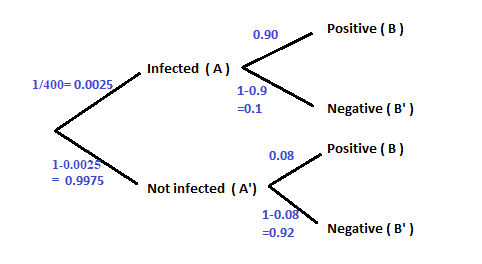A certain virus infects one in every 400 people. A test used to detect the virus in a person is positive 90% of the time if the person has the virus and 8% of the time if the person does not have the virus. (This 8% result is called a false positive.) Let A be the event "the person is infected" and B be the event "the person tests positive". a) Find the probability that a person has the virus given that they have tested positive, i.e. find P(A|B). Round your answer to the nearest tenth of a percent and do not include a percent sign. P(A|B)- b) Find the probability that a person does not have the virus given that they test negative, i.e. find P(A'|B'). Round your answer to the nearest tenth of a percent and do not include a percent sign. P(A'|B') =
A certain virus infects one in every 400 people. A test used to detect the virus in a person is positive 90% of the time if the person has the virus and 8% of the time if the person does not have the virus. (This 8% result is called a false positive.) Let A be the event "the person is infected" and B be the event "the person tests positive". a) Find the probability that a person has the virus given that they have tested positive, i.e. find P(A|B). Round your answer to the nearest tenth of a percent and do not include a percent sign. P(A|B)- b) Find the probability that a person does not have the virus given that they test negative, i.e. find P(A'|B'). Round your answer to the nearest tenth of a percent and do not include a percent sign. P(A'|B') =
A First Course in Probability (10th Edition)
10th Edition
ISBN:9780134753119
Author:Sheldon Ross
Publisher:Sheldon Ross
Chapter1: Combinatorial Analysis
Section: Chapter Questions
Problem 1.1P: a. How many different 7-place license plates are possible if the first 2 places are for letters and...
Related questions
Topic Video
Question

Transcribed Image Text:M0/1
A certain virus infects one in every 400 people. A test used to detect the virus in a person is positive 90% of
the time if the person has the virus and 8% of the time if the person does not have the virus. (This 8% result
is called a false positive.) Let A be the event "the person is infected" and B be the event "the person tests
positive".
a) Find the probability that a person has the virus given that they have tested positive, i.e. find P(A|B).
Round your answer to the nearest tenth of a percent and do not include a percent sign.
P(A|B)=
b) Find the probability that a person does not have the virus given that they test negative, i.e. find
P(A'|B'). Round your answer to the nearest tenth of a percent and do not include a percent sign.
P(A'|B') =
Question Help: D Video
Submit Question
9%
e here to search
***
F12
Prisc
** FIL
F10
F9
F7
&
%23
6
7
3
4.
Y
U
IT
E
11
J
G
S
C
Ctri
Alt
Alt
Expert Solution
Step 1
Let's draw tree diagram from given information ,
A : Event that the person is infected
P( A ) = 1/400 = 0.0025
B : Event that the person tests is positive.

we have ,
P( A ) = 0.0025 , P( A') = 0.9975
P( B | A ) = 0.9 , P( B' | A ) = 0.1
P( B | A' ) = 0.08 , P( B' | A' ) = 0.92
Trending now
This is a popular solution!
Step by step
Solved in 3 steps with 1 images

Knowledge Booster
Learn more about
Need a deep-dive on the concept behind this application? Look no further. Learn more about this topic, probability and related others by exploring similar questions and additional content below.Recommended textbooks for you

A First Course in Probability (10th Edition)
Probability
ISBN:
9780134753119
Author:
Sheldon Ross
Publisher:
PEARSON


A First Course in Probability (10th Edition)
Probability
ISBN:
9780134753119
Author:
Sheldon Ross
Publisher:
PEARSON
